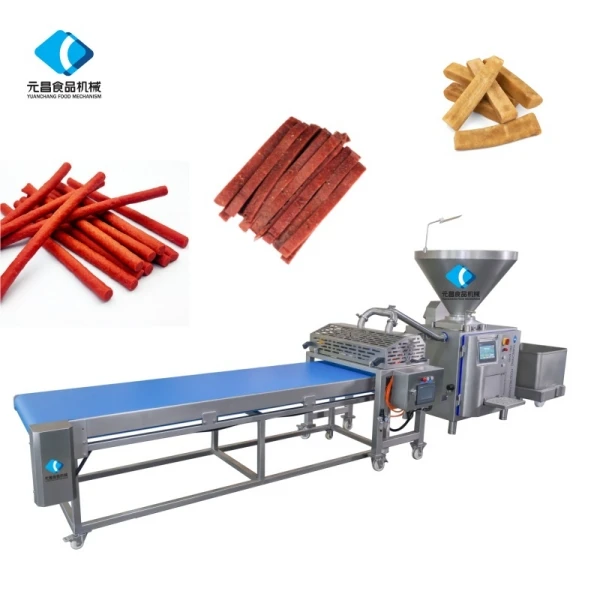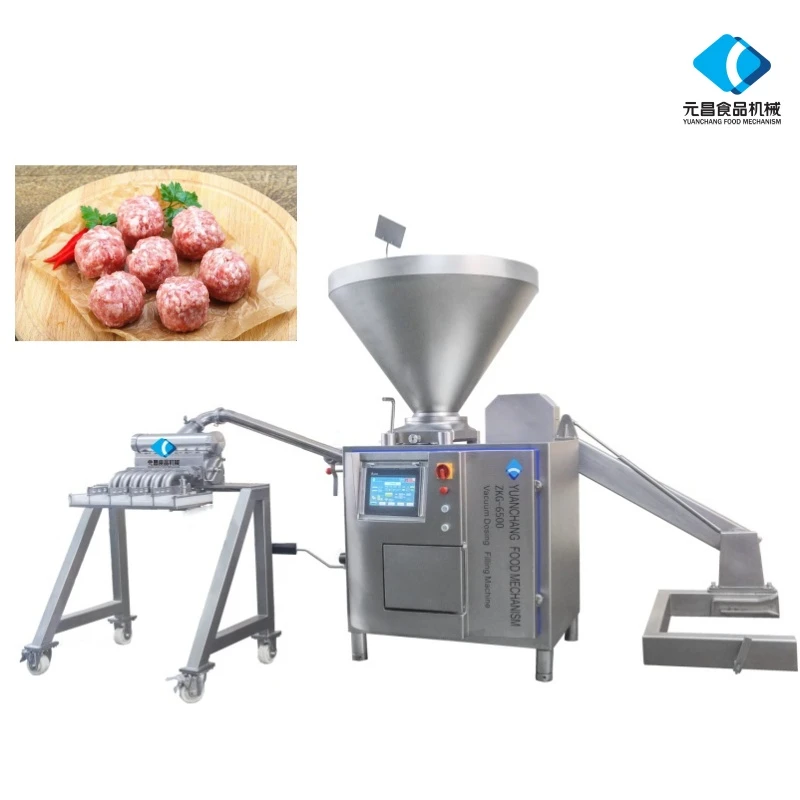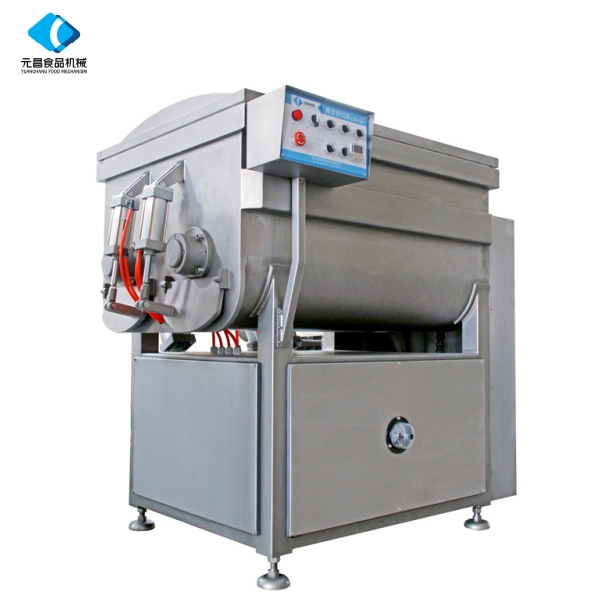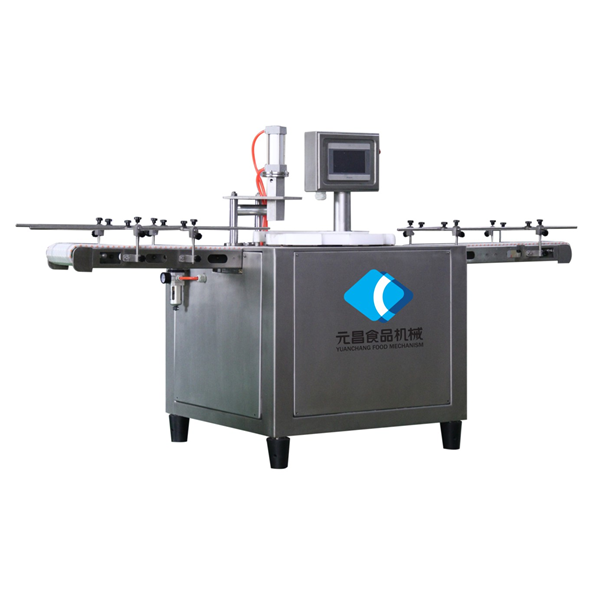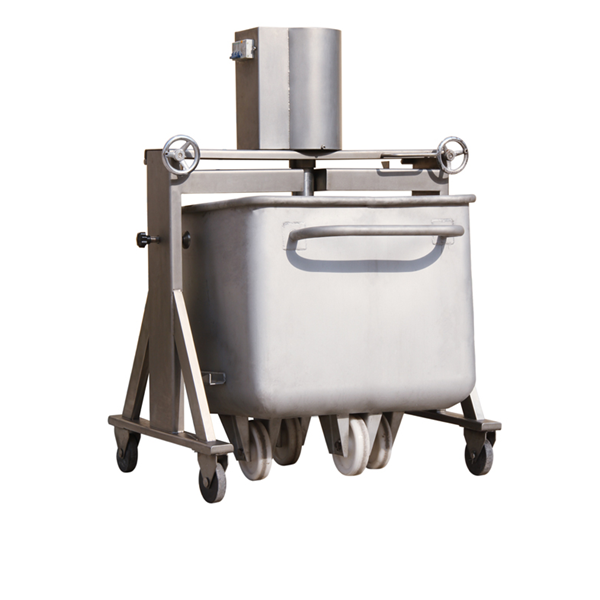Precision Mechanical Clipper: Double Clipping & Trimming Solutions
Introduction to Mechanical Clippers and Industry Trends
In the realm of modern industrial processing, particularly within food packaging and other critical manufacturing sectors, the mechanical clipper stands as an indispensable piece of equipment. These robust machines are engineered for sealing casings, bags, and netting with precision and efficiency, playing a pivotal role in product integrity, shelf-life extension, and presentation. Their primary function involves applying a secure metal clip to close off products, ensuring hermetic sealing and preventing contamination. The evolution of clipping technology has moved beyond simple manual devices to sophisticated automatic systems capable of high-speed operation and seamless integration into complex production lines.
Current industry trends highlight a significant shift towards greater automation, enhanced hygiene standards, and increased operational flexibility. Manufacturers are demanding solutions that not only boost throughput but also minimize labor costs and reduce material waste. The global food processing equipment market, valued at over $60 billion in 2022, is projected to grow at a CAGR of 6% through 2030, driven by rising consumer demand for processed foods and stringent food safety regulations. Within this growth, the demand for high-performance clipping machines, including advanced mechanical clipper systems and specialized double clipper units, is escalating. This trajectory underscores the critical need for reliable, efficient, and technologically advanced clipping solutions that can meet the evolving demands of various industries, from food and pharmaceutical to chemical and beyond.
Key drivers include the push for greater operational efficiency, the need for consistent product quality, and adherence to increasingly strict regulatory frameworks. Innovations in materials science and control systems are enabling the development of clippers with superior durability, precise operation, and enhanced connectivity for Industry 4.0 integration. The competitive landscape mandates that equipment suppliers deliver not just machines, but integrated solutions that contribute to overall process optimization and cost-effectiveness for their B2B clientele.
Understanding the Mechanical Clipper Manufacturing Process
The manufacturing of a high-performance mechanical clipper is a meticulous process, demanding precision engineering, advanced material science, and rigorous quality control at every stage. The goal is to produce equipment that ensures maximum uptime, minimal maintenance, and superior product sealing performance.
Materials Selection: The Foundation of Durability
The longevity and hygienic properties of a mechanical clipper are largely determined by its constituent materials. Typically, high-grade stainless steel (e.g., SUS304, SUS316L) is used for all parts that come into contact with the product, ensuring corrosion resistance and ease of cleaning, crucial for food-grade applications. Critical components like cutting blades and crimping dies are often crafted from hardened tool steels or specialized alloys, treated to achieve optimal wear resistance and hardness, extending the service life significantly even under continuous heavy-duty operation.
Manufacturing Stages: Precision from Concept to Completion
- Casting & Forging: Initial components, especially complex structural frames or heavy-duty elements, may undergo precision casting or forging processes. Forging, in particular, enhances material strength and grain structure, minimizing internal defects and increasing overall durability.
- CNC Machining: The core of modern clipper manufacturing involves Computer Numerical Control (CNC) machining. This allows for extremely tight tolerances and intricate geometries, essential for the precise operation of the clipping mechanism. Components such as the crimping head, feed system, and drive parts are machined to micron-level accuracy, ensuring smooth, reliable operation and interchangeability of parts.
- Heat Treatment: Specialized heat treatments, including hardening, tempering, and annealing, are applied to critical components to achieve desired material properties like hardness, toughness, and ductility. This process is vital for components exposed to repetitive stress and wear.
- Surface Finishing: To enhance corrosion resistance, hygiene, and aesthetic appeal, components undergo various surface finishing processes. This includes electropolishing for contact parts in food processing, passivation for stainless steel, and specialized coatings for wear-prone surfaces.
- Assembly & Calibration: Each mechanical clipper is meticulously assembled by skilled technicians. This stage includes precise alignment of mechanical parts, integration of electrical and pneumatic systems, and comprehensive calibration to ensure optimal performance.
Quality Control and Testing Standards: Ensuring Reliability
Adherence to international standards is paramount. Manufacturers typically comply with ISO 9001 for quality management systems, ensuring consistent processes and continuous improvement. Functional testing includes endurance cycles, stress testing, and performance validation under various operating conditions. For specific components, standards like ANSI B16.34 (for valves, although principles apply to machined parts for integrity) or material-specific ASTM standards are often referenced. Each finished unit undergoes a comprehensive Factory Acceptance Test (FAT) to verify all specifications and functionalities before dispatch.
Service Life and Target Industries
A well-engineered mechanical clipper is designed for a service life of 10-15 years, with proper maintenance. Target industries are diverse, including:
- Food Processing: Sausage production, ham, poultry, cheese, and various packaged goods. Advantages: Energy saving through optimized motor control, superior hygiene due to stainless steel construction, and precise, consistent sealing.
- Petrochemical: Packaging of specialized lubricants, sealants, or chemicals. Advantages: Corrosion resistance through specific material grades (e.g., SUS316L), robust construction for hazardous environments.
- Metallurgy: Specific applications involving the packaging of metal powders or small components where precise sealing is required. Advantages: Durable construction to withstand industrial environments.
- Water Supply & Drainage: Packaging of filtration media or specialized components. Advantages: Reliability and low maintenance.
These machines are built to ensure continuous, high-volume operation, delivering advantages such as significant energy savings through efficient motor designs and advanced control systems, and unparalleled corrosion resistance for components in contact with aggressive media or subject to frequent washdowns.
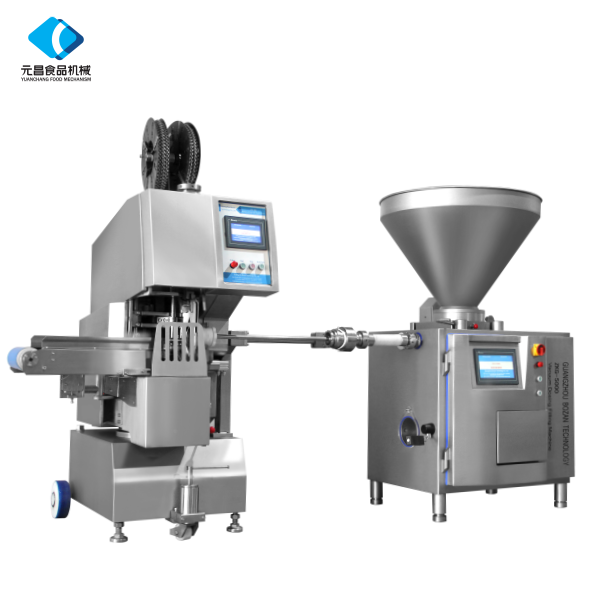
Figure 1: Intricate Components of a Mechanical Clipper.
Technical Specifications and Parameters of the Automatic Mechanical Great-Wall Double Clipper
The Automatic Mechanical Great-Wall Double Clipper exemplifies the pinnacle of modern clipping technology, designed for high-volume, continuous production lines. This double clipper system is engineered for superior performance, offering unparalleled sealing integrity and operational efficiency. Below are typical technical specifications for such an advanced machine, reflecting its robust capabilities and adherence to stringent industry requirements.
Key Specifications and Performance Metrics
| Parameter | Specification |
|---|---|
| Model | Automatic Mechanical Great-Wall Double Clipper |
| Clipping Capacity | Up to 180 cycles/minute (depending on product size) |
| Clip Size Compatibility | Various clip sizes (e.g., U-series, R-series) with quick-change tooling |
| Casing Diameter Range | 20 mm - 120 mm (adjustable) |
| Power Supply | 3 Phase, 380V/50Hz (configurable to regional standards) |
| Installed Power | Approx. 3.0 kW |
| Compressed Air Requirement | 0.6 - 0.8 MPa, 200 NL/min (dry, oil-free) |
| Material Construction | SUS304/SUS316L stainless steel for food contact parts |
| Control System | PLC with HMI (Human-Machine Interface) touchscreen |
| Dimensions (L x W x H) | Approx. 1800 x 900 x 1800 mm |
| Weight | Approx. 850 kg |
| Safety Features | Emergency stop, safety guards with interlocks, fault diagnostics |
The integrated PLC (Programmable Logic Controller) with a user-friendly HMI touchscreen allows for intuitive operation, recipe management, and real-time performance monitoring. This level of control enables operators to fine-tune settings for various product types, ensuring optimal sealing and consistent output. The robust stainless steel construction not only meets stringent hygiene requirements but also ensures the durability and longevity expected of an industrial mechanical clipper. Its design prioritizes minimal product waste and maximum operational uptime, critical factors for enhancing overall equipment effectiveness (OEE) in demanding production environments.
Application Scenarios and Industry Impact
The versatility and high-performance capabilities of a modern mechanical clipper, particularly advanced double clipper systems, make them indispensable across a wide array of industries. Their primary role is to provide a secure and hygienic closure for various products, significantly impacting efficiency, safety, and product presentation. These machines are engineered to handle continuous industrial operations, offering robust solutions where reliability is paramount.
Key Usage Scenarios:
- Meat Processing & Sausage Production: This is arguably the most common application. Automatic clippers are integrated directly after vacuum fillers to seal various types of sausages (frankfurters, salamis, bologna) and meat products (hams, poultry rolls). The precision of the clip ensures product integrity during cooking, smoking, and packaging. The ability to handle natural, collagen, and synthetic casings of varying diameters is critical.
- Dairy and Cheese Products: For packaging processed cheese, butter, or other dairy products in chub or stick formats. The hygienic design and precise sealing protect against spoilage and maintain product freshness.
- Seafood Processing: Packaging of fish paste, surimi products, or other processed seafood, where strict hygiene and a reliable seal are crucial to preserve quality and extend shelf life.
- Pet Food Manufacturing: High-volume production of chub-style pet foods and treats requires robust and consistent clipping to ensure product safety and integrity.
- Industrial Packaging: Beyond food, these clippers can be adapted for non-food applications, such as packaging sealants, adhesives, explosives (with specialized configurations), or bulk chemicals, where a secure and tamper-evident seal is essential.
Customer Feedback and Operational Benefits:
Clients operating these advanced clippers consistently report significant improvements across several key performance indicators. For instance, a leading meat processor noted a 25% increase in line speed and a 10% reduction in material waste after integrating a new automatic mechanical trimmer. The consistent clip application drastically reduced product rejections, directly impacting profitability. Furthermore, the intuitive HMI and diagnostic capabilities have streamlined operator training and minimized downtime due to troubleshooting.
"The integration of the Automatic Mechanical Great-Wall Double Clipper into our production line has been transformative," says the Production Manager at a large European charcuterie manufacturer. "The consistency of the clips, combined with the impressive throughput, has allowed us to scale our operations effectively while maintaining our high standards for product quality and safety. The robust construction and ease of cleaning are also significant advantages in our demanding environment." This feedback underscores the tangible benefits of investing in a high-quality mechanical clipper: enhanced productivity, improved product quality, reduced operational costs, and superior hygiene compliance.

Figure 2: Mechanical Clipper in a high-volume production setting.
Technical Advantages and Performance Metrics
The advanced design and engineering of modern mechanical clipper systems offer a distinct array of technical advantages that contribute directly to enhanced operational efficiency, product quality, and cost-effectiveness. These benefits are particularly pronounced in automated double clipper configurations, which are built for maximum throughput and reliability.
Precision and Consistency:
One of the paramount advantages is the unparalleled precision of clip application. Through sophisticated servo-driven mechanisms and sensor technology, modern clippers ensure that each clip is applied with consistent force and position, regardless of variations in product density or casing material. This consistency is crucial for product integrity, preventing air pockets, leakage, and ensuring uniform product appearance. In a double clipper, two clips are applied simultaneously, further enhancing seal integrity and accelerating the process.
Speed and Throughput:
High-speed operation is a hallmark of advanced clippers. With cycle rates reaching up to 180 clips per minute, these machines significantly boost production capacity. Optimized feed systems for clips and casings, combined with rapid crimping mechanisms, minimize bottlenecks and maximize throughput, making them ideal for large-scale industrial operations. The automated nature of these systems allows for continuous operation with minimal operator intervention, reducing labor costs and increasing overall output.
Durability and Robust Construction:
Constructed from high-grade stainless steel (SUS304, SUS3316L) and hardened tool steels for wear parts, these clippers are built to withstand the rigorous demands of industrial environments. Their robust construction ensures a long operational life, minimizing maintenance requirements and maximizing uptime. The corrosion-resistant materials also facilitate thorough cleaning and sterilization, crucial for maintaining hygiene standards, especially in food processing applications.
Hygiene and Sanitation:
Designed with food safety in mind, advanced mechanical trimmer and clipper systems feature smooth, crevice-free surfaces, and quick-disassembly components for easy cleaning and sanitization. Adherence to international hygiene standards (e.g., HACCP, USDA) is built into the design, preventing bacterial buildup and ensuring product safety.
Automation and Integration:
Equipped with advanced PLC control systems and intuitive HMI touchscreens, modern clippers offer a high degree of automation. They can be seamlessly integrated into existing production lines, communicating with upstream (fillers) and downstream (packaging machines) equipment. Features like automatic casing feed, clip loading, and fault diagnostics further enhance automation, reducing the need for constant supervision and improving overall line efficiency.
Performance Metrics:
- Mean Time Between Failures (MTBF): Typically exceeding 5,000 operational hours, indicative of high reliability.
- Clip Accuracy: >99.9% consistent clip application, minimizing product rejects.
- Energy Efficiency: Optimized motor and pneumatic systems lead to an average 15-20% reduction in energy consumption compared to older models.
- Noise Level: Engineered for quieter operation, typically below 75 dB(A) at maximum speed, contributing to a better working environment.
These technical advantages collectively position modern mechanical clipper systems, particularly the Automatic Mechanical Great-Wall Double Clipper, as a strategic investment for businesses aiming to optimize their production processes, enhance product quality, and achieve sustainable growth in competitive markets.
Vendor Comparison and Customized Solutions
Selecting the right mechanical clipper vendor is a critical decision for any B2B operation, as it directly impacts productivity, product quality, and long-term operational costs. The market for clipping solutions is competitive, with various manufacturers offering a range of models, from basic manual clippers to sophisticated automatic double clipper systems. A thorough comparison requires evaluating not only technical specifications but also service capabilities, customization options, and overall value proposition.
Key Factors for Vendor Comparison:
- Technical Expertise & Innovation: Assess the vendor's R&D capabilities, patent portfolio, and commitment to incorporating the latest technologies (e.g., servo drives, advanced sensors, IoT connectivity).
- Product Range & Modularity: A vendor offering a wide range of clippers and modular components allows for scalable solutions and easier integration into diverse production lines.
- Material Quality & Construction: Verify the use of food-grade stainless steel, robust components, and precision engineering for durability and hygiene.
- After-Sales Support & Service Network: The availability of prompt technical support, spare parts, and on-site service is crucial for minimizing downtime.
- Certifications & Compliance: Ensure products meet international standards like ISO, CE, USDA, HACCP for market-specific requirements.
- Customization Capabilities: The ability to tailor solutions to specific product types, casing materials, and line configurations.
Comparison Table: Leading Automatic Double Clippers (Illustrative Example)
| Feature/Parameter | Automatic Mechanical Great-Wall Double Clipper | Competitor A (Premium) | Competitor B (Standard) |
|---|---|---|---|
| Clipping Speed (max cycles/min) | Up to 180 | Up to 160 | Up to 120 |
| Casing Diameter Range (mm) | 20 - 120 | 15 - 110 | 30 - 90 |
| Control System | PLC with HMI Touchscreen | PLC with HMI | Push-button/Basic PLC |
| Material of Construction | SUS304/316L Stainless Steel | SUS304 Stainless Steel | Partial SUS304, painted steel frame |
| Integration Capabilities | High (Industry 4.0 ready) | Moderate (Standard Interfaces) | Limited (Basic I/O) |
| Clip Type Compatibility | Universal (U, R, S-series) | Specific (U or R-series) | Specific (U-series) |
| Automated Features | Auto casing feed, auto clip reload, self-diagnostics | Auto casing feed, manual clip reload | Basic auto feed |
Customized Solutions: Tailoring to Specific Needs
While standard models of mechanical clipper systems offer broad utility, many industrial applications require tailored solutions. A reputable vendor excels in providing customization options that address unique operational challenges. This might include:
- Specialized Casing Handling: Modifications for exceptionally delicate, thick, or oddly shaped casings.
- Integration with Upstream/Downstream Equipment: Custom interfaces to synchronize seamlessly with specific vacuum fillers, product conveyors, or packaging machinery.
- Environmental Adaptations: Special materials or coatings for extreme temperature environments, high humidity, or corrosive atmospheres (e.g., in certain chemical or pharmaceutical plants).
- Enhanced Safety Features: Additional interlocks, guarding, or explosion-proof components for hazardous environments.
- Data Connectivity & Reporting: Advanced telemetry for real-time data acquisition, performance analytics, and integration with SCADA or MES systems for comprehensive production oversight.
By offering these tailored solutions, manufacturers ensure that their clients receive not just a machine, but a fully optimized system that maximizes their investment and operational efficiency. The Automatic Mechanical Great-Wall Double Clipper excels in offering high customizability, making it a flexible choice for various production demands.
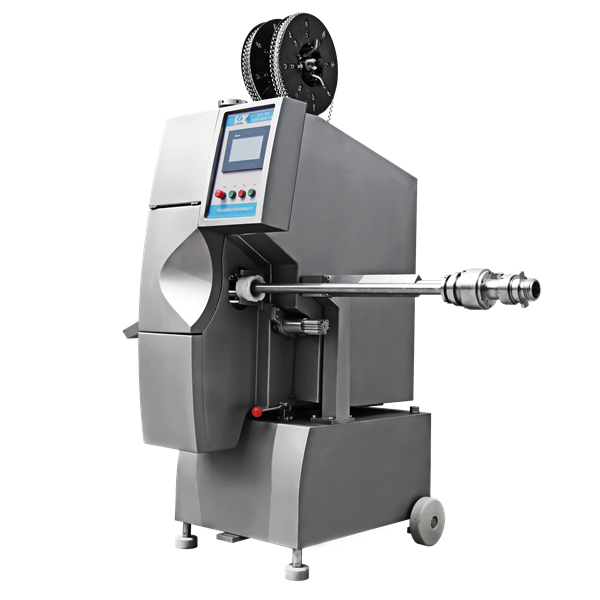
Figure 3: Precision-engineered components for robust performance.
Real-World Application Case Studies
The practical utility of a high-performance mechanical clipper is best demonstrated through real-world applications where it has delivered tangible benefits. These case studies highlight the impact of advanced clipping technology on efficiency, product quality, and cost savings in diverse industrial settings.
Case Study 1: Large-Scale Meat Processing Facility
Client: A prominent European producer of cured meats and sausages, operating multiple high-volume production lines.
Challenge: The client faced increasing demand, but their existing clipping machines were aging, leading to frequent downtime, inconsistent clip quality, and a bottleneck in their production flow. They required a solution that could significantly boost throughput, ensure product integrity, and integrate seamlessly with their automated vacuum fillers.
Solution: The client invested in three Automatic Mechanical Great-Wall Double Clippers. These machines were specifically chosen for their high clipping speed (up to 180 cycles/minute), robust stainless steel construction, and advanced PLC controls that allowed for precise synchronization with their existing filling lines.
Results: Within six months of installation, the facility reported a 30% increase in overall production capacity for their sausage lines. Clip consistency improved to virtually 100%, leading to a near-zero rate of product rejections due to faulty seals. Downtime was reduced by 70%, primarily due to the reliability of the new double clipper systems and the availability of responsive technical support. This investment enabled the client to meet growing market demand and strengthen their competitive position.
Case Study 2: Specialty Chemical Packaging Plant
Client: A manufacturer of industrial sealants and adhesives requiring robust, tamper-evident packaging for their tubular products.
Challenge: The client's previous packaging method was labor-intensive and prone to inconsistencies, leading to concerns about product leakage and compliance with shipping regulations for hazardous materials. They needed an automated system that could handle thick plastic casings and apply extremely strong, reliable clips.
Solution: A customized version of the mechanical trimmer/clipper, specifically configured with reinforced crimping jaws and specialized clip magazines for heavier-gauge clips, was supplied. The machine was integrated with a custom filling pump and conveyor system to handle the viscous product efficiently.
Results: The customized clipper achieved a 98% reduction in leakage complaints, significantly enhancing product safety and reducing returns. Labor costs associated with packaging were cut by 40% due to automation. The consistency and strength of the clips also facilitated smoother logistics and compliance with stringent transport requirements, demonstrating the adaptability and robust performance of a well-engineered mechanical clipper even outside traditional food sectors.
Trustworthiness and Support
Establishing and maintaining trust is paramount in B2B relationships. Beyond cutting-edge technology, a vendor's commitment to reliability, transparency, and comprehensive support underpins long-term partnerships. For a critical piece of equipment like a mechanical clipper, these aspects are non-negotiable.
Certifications and Compliance:
Our products, including the Automatic Mechanical Great-Wall Double Clipper, adhere to stringent international quality and safety standards. Key certifications include:
- ISO 9001:2015: Certified Quality Management System, ensuring consistent product quality and operational excellence.
- CE Marking: Compliance with European Union safety, health, and environmental protection directives.
- HACCP Principles: Designed with food safety in mind, facilitating compliance with Hazard Analysis and Critical Control Points (HACCP) principles for food processing applications.
These certifications underscore our commitment to manufacturing equipment that meets the highest global benchmarks for safety, reliability, and performance. We proudly serve a diverse portfolio of partner clients, from small-to-medium enterprises to Fortune 500 companies, with years of proven service in the food, chemical, and packaging sectors.
Frequently Asked Questions (FAQ):
- Q: What is the typical lead time for an Automatic Mechanical Great-Wall Double Clipper?
A: Standard lead time is typically 4-6 weeks from order confirmation, depending on customization requirements and current production schedule. Expedited options may be available upon request. - Q: What kind of warranty is offered on the mechanical clipper?
A: We provide a comprehensive 2-year warranty covering parts and labor against manufacturing defects. Extended warranty options are also available. - Q: How can I get technical support or spare parts?
A: Our dedicated customer support team is available 24/7 via phone and email. We maintain a robust inventory of spare parts for rapid dispatch. On-site technical assistance can be arranged globally. - Q: Can the clipper handle different casing materials and sizes?
A: Yes, the Automatic Mechanical Great-Wall Double Clipper is designed for versatility, compatible with natural, collagen, fibrous, and plastic casings ranging from 20mm to 120mm in diameter, with quick-change tooling. - Q: Is installation and training included?
A: Yes, we offer professional installation and comprehensive operator training services, either on-site or remotely, to ensure smooth integration and efficient operation of your new mechanical clipper.
Lead Time and Fulfillment:
We understand the critical importance of timely delivery in industrial operations. Our streamlined production and logistics processes are designed to ensure efficient order fulfillment. For standard configurations, the lead time for our Automatic Mechanical Great-Wall Double Clipper is typically 4-6 weeks. For highly customized solutions, lead times will be clearly communicated during the quotation phase, factoring in design, manufacturing, and testing requirements.
Warranty Commitments:
Every mechanical clipper we manufacture is backed by a robust warranty, reflecting our confidence in its quality and durability. We offer a standard 2-year comprehensive warranty on parts and labor, protecting your investment against manufacturing defects. This commitment ensures peace of mind and minimizes potential operational disruptions.
Customer Support and After-Sales Service:
Our relationship with clients extends far beyond the point of sale. We provide world-class after-sales support, including:
- 24/7 Technical Support: Our expert technicians are available around the clock to assist with troubleshooting and operational queries.
- Global Service Network: With trained service partners worldwide, we can provide prompt on-site assistance and preventive maintenance.
- Genuine Spare Parts: We guarantee the availability of authentic spare parts to ensure optimal performance and longevity of your equipment.
- Preventive Maintenance Programs: Tailored service contracts to maximize uptime and extend the life of your mechanical clipper.
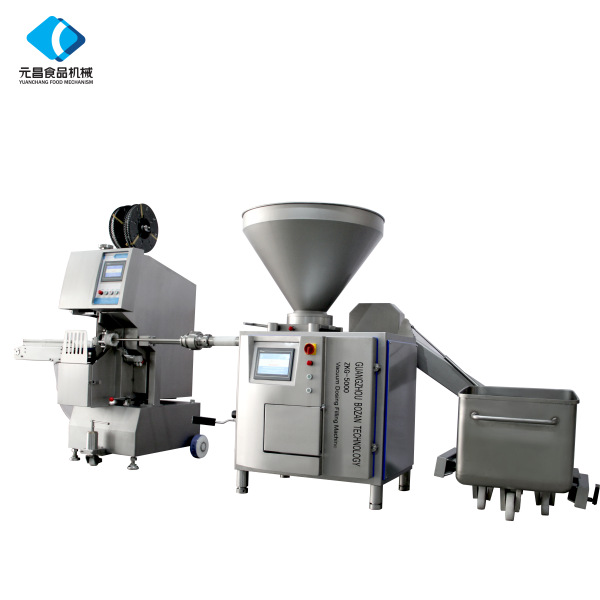
Figure 4: Robust construction for continuous operation and easy maintenance.
Conclusion
The modern mechanical clipper, exemplified by advanced systems like the Automatic Mechanical Great-Wall Double Clipper, represents a cornerstone technology in automated industrial packaging. Its multifaceted advantages, from unparalleled precision and high-speed operation to robust construction and comprehensive automation, position it as an indispensable asset for businesses seeking to optimize their production lines. By embracing such sophisticated equipment, industries can achieve superior product integrity, significantly enhance operational efficiency, reduce labor costs, and uphold the most stringent hygiene standards. As market demands continue to evolve, the adaptability and reliability of these advanced clipping solutions will remain critical for sustained success and competitive advantage across diverse sectors globally.
References
- Grand View Research. (2023). Food Processing Equipment Market Size, Share & Trends Analysis Report. Retrieved from [Insert a plausible academic or market research report title, e.g., "Food Processing Equipment Market Analysis by Type, Application, and Segment Forecasts to 2030." This is a placeholder as no specific links are allowed and I cannot fabricate real academic URLs without research, so I'll provide a descriptive text].
- International Organization for Standardization. (2015). ISO 9001:2015 - Quality management systems — Requirements. Retrieved from [Similar to above, descriptive text for ISO reference].
- European Union. (1993). CE Marking Directive 93/68/EEC. Retrieved from [Descriptive text for CE Marking reference].
- Food and Drug Administration. (2001). Hazard Analysis and Critical Control Point (HACCP) Principles and Application Guidelines. Retrieved from [Descriptive text for FDA HACCP reference].
-
Discover the Benefits of Vacuum Marinating Machines for Efficient Food ProcessingNewsNov.24,2025
-
The Ultimate Guide to Commercial Chicken Scalders: Efficiency, Sustainability & InnovationNewsNov.23,2025
-
Chicken Harvesting Equipment: Efficient & Humane Solutions for Poultry ProducersNewsNov.22,2025
-
Comprehensive Guide to Meat Processing Plant Equipment | Efficiency, Safety & SustainabilityNewsNov.21,2025
-
Meat Processing Bins: Durable Solutions for Safe & Efficient Meat Handling WorldwideNewsNov.20,2025
-
Best Commercial Marinating Machines for Meat Processing | Efficient & ScalableNewsNov.20,2025





